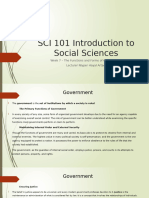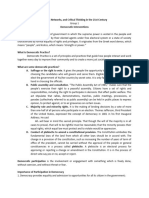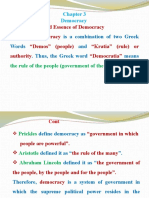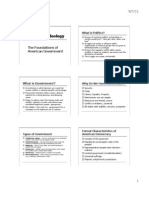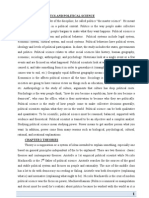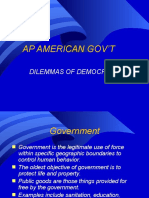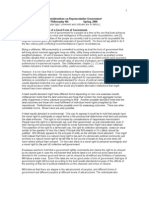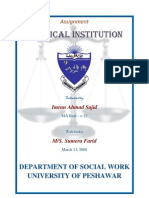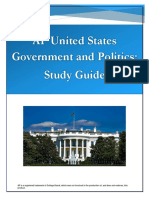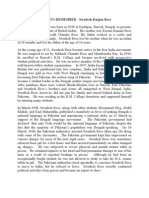Chapter 1: The Democratic Republic
Chapter 1: The Democratic Republic
Uploaded by
nalla_lykanCopyright:
Available Formats
Chapter 1: The Democratic Republic
Chapter 1: The Democratic Republic
Uploaded by
nalla_lykanOriginal Description:
Copyright
Available Formats
Share this document
Did you find this document useful?
Is this content inappropriate?
Copyright:
Available Formats
Chapter 1: The Democratic Republic
Chapter 1: The Democratic Republic
Uploaded by
nalla_lykanCopyright:
Available Formats
1
CHAPTER 1
The Democratic Republic
LEARNING OUTCOMES
The eight learning outcomes below are designed to help improve your understanding of this
chapter. After reading this chapter, you should be able to:
Learning Outcome 1: Define the terms politics and government.
Learning Outcome 2: Explain some of the ways in which Americans interact with their
government.
Learning Outcome 3: State what is meant by the words order, liberty, authority, and
legitimacy.
Learning Outcome 4: Distinguish the major features of direct democracy and
representative democracy.
Learning Outcome 5: Describe majoritarianism, elite theory, and pluralism as theories
of how democratic systems work.
Learning Outcome 6: Summarize the conflicts that can occur between the principles of
liberty and order, and also those of liberty and equality.
Learning Outcome 7: Discuss conservatism, liberalism, and other popular American
ideological positions.
Learning Outcome 8: Determine how the basic political principles addressed in this
chapter were reflected in the 2012 elections.
2
KEY TERMS
anarchy The condition of no government.
aristocracy Rule by the best; in reality, rule by members of the upper class.
authoritarianism A type of regime in which only the government itself is fully controlled by the
ruler. Social and economic institutions exist that are not under the governments control.
authority The right and power of a government or other entity to enforce its decisions.
Bill of Rights The first ten amendments to the U.S. Constitution.
capitalism An economic system characterized by the private ownership of wealth-creating
assets, free markets, and freedom of contract.
civil liberties Those personal freedoms, including freedom of religion and freedom of speech,
that are protected for all individuals. The civil liberties set forth in the U.S. Constitution,
as amended, restrain the government from taking certain actions against individuals.
consent of the people The idea that governments and laws derive their legitimacy from the
consent of the governed.
conservatism A set of beliefs that includes a limited role for the national government in
helping individuals, support for traditional ideals and life choices, and a cautious
response to change.
conservative movement An American movement in the 1950s that provided a comprehensive
ideological framework for conservative politics.
democracy A system of government in which political authority is vested in the people. The
term is derived from the Greek words demos (the people) and kratos (authority).
democratic republic A republic in which representatives elected by the people make and
enforce laws and policies.
direct democracy A system of government in which political decisions are made by the people
directly, rather than by their elected representatives; probably attained most easily in
small political communities.
elite theory A perspective holding that society is ruled by a small number of people who
exercise power to further their self-interests.
equality As a political value, the idea that all people are of equal worth.
government The preeminent institution within society in which decisions are made that resolve
conflicts and allocate benefits and privileges. It is unique because it has the ultimate
authority for making these decisions.
ideology A comprehensive set of beliefs about the nature of people and about the role of an
institution or government.
initiative A procedure by which voters can propose a law or a constitutional amendment.
institution An ongoing organization that performs certain functions for society.
legislature A governmental body primarily responsible for the making of laws.
legitimacy Popular acceptance of the right and power of a government or other entity to
exercise authority.
3
liberalism A set of beliefs that includes the advocacy of positive government action to improve
the welfare of individuals, support for civil rights, and tolerance for political and
social change.
libertarianism A political ideology based on skepticism or opposition toward most
government activities.
liberty The greatest freedom of the individual that is consistent with the freedom of other
individuals in the society.
limited government A government with powers that are limited either through a written
document or through widely shared beliefs.
majoritarianism A political theory holding that, in a democracy, the government ought to do
what the majority of the people want.
majority More than 50 percent.
majority rule A basic principle of democracy asserting that the greatest number of citizens in
any political unit should select officials and determine policies.
oligarchy Rule by a few.
order A state of peace and security. Maintaining order by protecting members of society from
violence and criminal activity is one of the oldest purposes of government.
pluralism A theory that views politics as a conflict among interest groups. Political decision
making is characterized by compromise and accommodation.
political culture A patterned set of ideas, values, and ways of thinking about government and
politics that characterize a people.
political socialization The process by which political beliefs and values are transmitted to new
immigrants and to our children. The family and the educational system are the most
important sources of the political socialization process.
politics The process of resolving conflicts and deciding who gets what, when, and how. More
specifically, politics is the struggle over power or influence within organizations or
informal groups that can grant benefits or privileges.
popular sovereignty The concept that ultimate political authority is based on the will of
the people.
progressive A popular alternative to the term liberal.
property Anything that is or may be subject to ownership. As conceived by the political
philosopher John Locke, the right to property is a natural right superior to human law
(laws made by government).
recall A procedure allowing the people to vote to dismiss an elected official from state office
before his or her term has expired.
referendum An electoral device whereby legislative or constitutional measures are referred by
the legislature to the voters for approval or disapproval.
representative democracy A form of government in which representatives elected by the people
make and enforce laws and policies; may retain the monarchy in a ceremonial role.
republic A form of government in which sovereign power rests with the people, rather than with
a king or a monarch.
4
socialism A political ideology based on strong support for economic and social equality.
Socialists traditionally envisioned a society in which major businesses were taken over by
the government or by employee cooperatives.
theocracy Rule by God, or the gods; in practice, rule by religious leaders, typically self-appointed.
totalitarian regime A form of government that controls all aspects of the political, social, and
economic life of a nation.
universal suffrage The right of all adults to vote for their government representatives.
CHAPTER OUTLINE
Although we do provide some demographic projections at the end of the chapter, the basic point
of Chapter 1 is to introduce a series of concepts that are basic to understanding American
government and politics, and indeed, political science in general.
What If WE HAD NO BILL OF RIGHTS?
This feature explores what could happen without our fundamental guarantees
found in the first ten Amendments to the Constitution.
I. Politics and Government
Key concepts: politics, institution, government.
o Politics is the process of resolving conflicts and deciding, as Laswell
puts it, who gets what, when, and how. It is the struggle over power or
influence within organizations or informal groups that can grant or
withhold benefits or privileges.
o An institution is an ongoing organization that performs certain functions
for society.
o Government is the preeminent institution within a society. In
government, decisions are made that resolve conflicts and allocate
benefits and privileges. It is unique because it has the ultimate authority
for making these decisions and establishing political values.
II. Government Is Everywhere
A. From Your Birth
Government is involved in birth records, safety records, and the design and
implementation of educational programs. In the community, citizens may
encounter government employees such as police, court employees, or even
jail staff.
B. Throughout Your Life
The government issues drivers licenses, provides aid to colleges, and collects
sales and payroll taxes.
2012 Elections
C. To Your Death
The government provides fifty percent of all health-care funding, administers the
Social Security System, and regulates how heirs will receive the distribution of
estate assets.
III. Why Is Government Necessary?
5
A. The Need for Security
Key concept: order, that is, a state of peace and security. Maintaining order by
protecting members of society from violence and criminal activity is the one of
the oldest purpose of government.
1. The Example of Afghanistan.
2. The Loss of Security in Afghanistan.
B. Limiting Government Power
Key concept: liberty, or the greatest freedom of the individual that is consistent
with the freedom of other individuals in the society.
C. Authority and Legitimacy
Two more key concepts: authority is the right and power of a government or
other entity to enforce its decisions and compel obedience; legitimacy is popular
acceptance of the right and power of a government or other entity to exercise
authority (consent of the governed).
IV. Democracy and Other Forms of Government
A. Types of Government
Totalitarian RegimeA form of government that controls all aspects of
the political and social life of a nation.
AuthoritarianismA type of regime in which only the government
itself is fully controlled by the ruler. Social and economic institutions
exist that are not under the governments control.
AristocracyRule by the best; in reality, rule by members of the
upper class.
TheocracyRule by God, or the gods; in practice, rule by self-
appointed religious leaders, typically self-appointed.
OligarchyRule by a few.
AnarchyCondition of no government.
B. Direct Democracy as a Model
Direct DemocracyA system of government in which political
decisions are made by the people directly, rather than by their
elected representatives; probably attained most easily in small
political communities.
o The most important feature of Athenian democracy was that the
legislature (A governmental body primarily responsible for the
making of laws) was composed of all of the citizens.
Implementation
o InitiativeProcedure by which voters can propose a law or a
constitutional amendment.
o ReferendumElectoral device whereby legislative or
constitutional measures are referred by the legislature to the
voters for approval or disapproval.
o RecallProcedure allowing the people to vote to dismiss
an elected official from state office before his or her term
has expired.
C. The Dangers of Direct Democracy
While the founders believed in government based on the consent of the people,
they were highly distrustful of anything that might look like mob rule.
6
Therefore, they devised institutions to filter the popular will through
elected elites.
D. A Democratic Republic
A republic refers to a form of government in which sovereign power
rests with the people, rather than with a king or a monarch. A republic is
based on popular sovereignty. A democratic republic refers to a
republic in which representatives elected by the people makes and
enforces laws and policies. A representative democracy is a form of
government in which representatives elected by the people make and
enforce laws and policies, but may retain the monarchy in a ceremonial
rule.
Democratic republic and representative democracy really mean the same
thinggovernment based on elected representativesexcept for the
historical quirk that a republic cannot have a vestigial king.
1. Principles of Democratic Government. These include universal
suffrage, or the right of all adults to vote for their government or
representatives, and majority rule, which means that the greatest
number of citizens in any political unit should select the officials and
determine policies.
2. Constitutional Democracy. The key concept is: limited government, a
government in which powers are limited either through a written
document or through widely shared beliefs. Without such limits,
political decisions may be based on the whims or ambitions of
individuals in government.
V. What Kind of Democracy Do We Have?
A. Democracy for Everyone
Majoritarianism: A political theory holding that, in a democracy, the
government ought to do what the majority of the people want. Popular as a
principal, but not very good at explaining what really happens in our system.
B. Democracy for the Few
Elite Theory: A perspective holding that society is ruled by a small number of
people who exercise power to further their self-interests. It assumes the
population has little if any impact on the decision-making process. Ultimately,
policy decisions are made by a select few within the society who share a goal
of governmental stability because they do not want their position within
society jeopardized.
C. Democracy for Groups
Pluralism: A theory that views politics as a conflict among interest groups. It
assumes that numerous factions (or interest groups) work to affect policy. Each
faction works to promote the interests of the faction, and political decisions are
made through bargaining and compromise.
VI. Fundamental Values
Why is our system stable? It is stable, in part, because of a shared political culture,
which is a patterned set of ideas, values, and ways of thinking about government and
politics that characterize a people. Political culture is passed on through political
socialization to new immigrants and to our children largely by the family and the
7
educational system. The resulting dominant culture in America is based on values,
customs, and language inherited from Western European civilization.
A. Liberty versus Order
Personal freedom and order, or security, can come into conflict. Examples are the
loss of civil liberties during wartime and cultural conflicts such as the one over
abortion. Civil liberties are those personal freedomsincluding freedom of
religion and speechthat are protected for all individuals. They restrain the
government from taking certain actions against individuals.
Beyond Our Borders: RESTRICTIONS ON CIVIL LIBERTIES IN
OTHER DEMOCRATIC COUNTRIES
Examples of restrictions:
Germany restricts the use of the Swastika and the publication of Hitlers
autobiography, Mein Kampf.
Japanese citizens may be held without access to a lawyer for up to
twenty-three days.
B. Equality versus Liberty
Equality is the idea that all people are of equal worth. Equality under the law
regardless of race, religion, or gender is a popular value today, but was not
accepted as a norm even fifty years ago. Equality of opportunity is a concept with
much support.
1. Economic Equality. This concept is more controversial. It came into
play during the 1800s, especially as promoted by the European socialist
movements (which are not specifically named in this section).
2. Property Rights and Capitalism. Economic equality as a value comes
into conflict with property rights and with the capitalist system in
general. Key concepts: propertyAnything that is or can be subject to
ownership; capitalisman economic system characterized by the private
ownership of wealth-creating assets, free markets, and freedom of
contract.
Which Side Are You On? IS INEQUALITY NECESSARILY BAD?
This section examines the meaning of our commitment to equality in the United
States and analyzes when inequality becomes more fair and beneficial.
C. The Proper Size of Government
Contradictory opinions on big government.
Complaints about taxes versus complaints about poor
government services.
1. Big Government: The Response to Terrorism.
9/11 required a big response from government.
March, 2003: U.S. forces occupy Iraq.
U.S. forces faced an apparently endless insurrection.
Iraq war became a symbol of an over-ambitious government.
2. Big Government: The Great Recession.
September, 2008: A financial meltdown threatened
world economy.
8
Americans demanded government action.
$700 billion dollar bailout of banks and financial institutions.
Democrats take over in 2008.
Obama administration rescues auto industry.
Each step ultimately unpopular.
Patient Protection and Affordable Health Care Act
o Obamas major health care initiative example of
big government.
o Democrats criticized for big government and
Republicans take over in 2010.
VII. Political Ideologies
A political ideology is a closely linked set of beliefs about politics.
A. Conservatism
Key concept: conservatismA set of beliefs that includes a limited role for the
national government in helping individuals, support for traditional ideals and life
choices, and a cautious response to change.
1. Modern Conservatism. Key concept: Conservative movementAn
American movement in the 1950s that provided a comprehensive
ideological framework for conservative politics.
2. Conservative Values.
Places a high value on liberty.
Tends to favor limited governmental involvement in the
economic sector.
Sees economic freedom as a necessity for the good of
the society.
Places a high value on the principle of order and advocate
governmental involvement to preserve traditional values
and lifestyles.
Politics and Popular Movements: THE TEA PARTY MOVEMENT AND
THE OCCUPY TOGETHER MOVEMENTS
Examines the organization and purposes of liberal and conservative movements
in 2012 U.S. politics.
B. Liberalism
Key Concept: LiberalismA set of beliefs that includes the advocacy of
positive government action to improve the welfare of individuals, support for
civil rights, and tolerance for political and social change.
1. Modern Liberalism.
2. Liberal Values.
Places a high value on social and economic equality.
Tends to favor governmental regulation of the economy to
benefit individuals within the society.
Advocates that the government takes positive action to reduce
poverty, to redistribute income from wealthier classes to poorer
classes to regulate the economy.
Sees social freedom as a necessity for the good of the society.
9
C. The Traditional Political Spectrum
Key concept: Socialisma political ideology based on strong support for
economic and social equality. Socialists traditionally envisioned a
society in which major businesses were taken over by the government or
by employee cooperatives.
Key concept: Libertarianisma political ideology based on skepticism
or opposition toward most government activities.
D. Problems with the Traditional Political Spectrum
The complexities of todays political ideologies mean that there is a
large overlap.
E. A Four-Cornered Ideological Grid
We can break down the electorate into cultural and economic liberals, cultural
and economic conservatives, cultural liberals/economic conservatives
(libertarians), and cultural conservatives/economic liberals, conservatives
and progressives.
1. Economic Liberals, Cultural Conservatives.
2. Libertarians.
3. Conservatives and Progressives.
Key concept: ProgressiveA popular alternative to the term liberal.
VIII. One Nation, Divided
Conservatives and Republicans: Liberal Republicans have vanished.
Liberalism and Democrats: Conservative Democrats are few.
Little political party overlap.
Political Polarization: Parties find themselves at opposite ends of policy, each
voting in a bloc.
A. Political Gridlock
2009/2010 Democratic initiatives were passed with no Republican support.
Tea Party members in Republican Party were sworn to reject compromise
with Democrats.
You might also like
- Philippine Government and ConstitutionDocument59 pagesPhilippine Government and ConstitutionMarvin Xylon M. Jaen50% (4)
- Eoir33icen San Francisco 02082022Document2 pagesEoir33icen San Francisco 02082022Eddy Yoselin Cordero VargasNo ratings yet
- DEL DXB: TICKET - ConfirmedDocument2 pagesDEL DXB: TICKET - ConfirmedSohaib DurraniNo ratings yet
- Types of Government 3Document7 pagesTypes of Government 3bmoneybookings100No ratings yet
- SCI 101 Week 7 The Functions Forms of GovernmentDocument15 pagesSCI 101 Week 7 The Functions Forms of Governmentzerouali.islam99No ratings yet
- Polgov PDFDocument6 pagesPolgov PDFZhainab TolentinoNo ratings yet
- Chapter 1 NotesDocument4 pagesChapter 1 Notesapi-229040920No ratings yet
- AP Gov Chapter 1 Vocab SabatoDocument1 pageAP Gov Chapter 1 Vocab SabatoAlex EnsingNo ratings yet
- Lesson 2 Politics and GovernmentDocument5 pagesLesson 2 Politics and Governmentassemayad6No ratings yet
- Liberal Theory of StateDocument10 pagesLiberal Theory of StateShristi DeyNo ratings yet
- Democracy, Government Failure and CorruptionDocument48 pagesDemocracy, Government Failure and CorruptionManisita SamalNo ratings yet
- Political IdeologyDocument9 pagesPolitical IdeologyQueen Ching Genargue100% (1)
- Democracy&GovernanceDocument18 pagesDemocracy&Governancevaidruti bodiNo ratings yet
- Political Organization of Societies: 1. OverviewDocument5 pagesPolitical Organization of Societies: 1. OverviewscribdeterrizaNo ratings yet
- Trends q4 ReportingDocument22 pagesTrends q4 ReportingNicole GarciaNo ratings yet
- Civics Course Power Point Chapter 3Document45 pagesCivics Course Power Point Chapter 3abenezerNo ratings yet
- Trends Lecture Notes Q2Document10 pagesTrends Lecture Notes Q2Pagaduan R-mie JaneNo ratings yet
- Philippines Politics and GovernanceDocument72 pagesPhilippines Politics and GovernanceMa IsabelNo ratings yet
- Concept of GovernanceDocument4 pagesConcept of Governancejoanalaelebidion1990No ratings yet
- Government and Politics PDFDocument8 pagesGovernment and Politics PDFAsm ParvezNo ratings yet
- Topic-6-Democratic InterventionsDocument6 pagesTopic-6-Democratic InterventionsPatricia GarciaNo ratings yet
- Introduction To Politics and GovernmentDocument63 pagesIntroduction To Politics and Governmentkasahun796No ratings yet
- Chapter 1 Discussion Questions: 1. Define GovernmentDocument2 pagesChapter 1 Discussion Questions: 1. Define Governmentmiguel0angel0ramos-1No ratings yet
- Political ScienceDocument22 pagesPolitical Scienceeugenekylecabbab26No ratings yet
- Political ScienceDocument10 pagesPolitical ScienceSaad WarraichNo ratings yet
- CH 1 - Democracy and American PoliticsDocument9 pagesCH 1 - Democracy and American PoliticsAndrew Philip ClarkNo ratings yet
- Democracyy PDFDocument3 pagesDemocracyy PDFZakir AhmadNo ratings yet
- DemocracyDocument3 pagesDemocracyZakir AhmadNo ratings yet
- Democracy and The LawDocument10 pagesDemocracy and The Lawbulbulkarn0418No ratings yet
- Sure, Here's A Detailed Exploration of Democracy From Various Perspectives. - 20240518 - 105819 - 0000Document10 pagesSure, Here's A Detailed Exploration of Democracy From Various Perspectives. - 20240518 - 105819 - 0000Jaee ChavanNo ratings yet
- SOC2301 UNIT 1 Democracy in Indian and ChallengesDocument26 pagesSOC2301 UNIT 1 Democracy in Indian and Challengesinukakodkar438No ratings yet
- LEARNING ACTIVITY SHEET Social and Political I.Document4 pagesLEARNING ACTIVITY SHEET Social and Political I.FELINOR ABELLANOZANo ratings yet
- Political SpectrumDocument3 pagesPolitical SpectrumSun KimNo ratings yet
- lecture 4Document50 pageslecture 4kinzaafatima22No ratings yet
- Sample Project PPGCDocument74 pagesSample Project PPGCHanahNo ratings yet
- Philippine Politics Berhns NotesDocument23 pagesPhilippine Politics Berhns NotesCarlo JainarNo ratings yet
- Political Science Essay StructureDocument20 pagesPolitical Science Essay StructureRoman GNo ratings yet
- Summary and Reflection PaperDocument8 pagesSummary and Reflection PapersoknaranNo ratings yet
- Democracy: "I Understand Democracy As Something That Gives The Weak The Same Chance As The Strong."Document18 pagesDemocracy: "I Understand Democracy As Something That Gives The Weak The Same Chance As The Strong."resfreakNo ratings yet
- Road To Democracy FDocument13 pagesRoad To Democracy Fsayma meemNo ratings yet
- Type of GovernmentDocument3 pagesType of Government17 Zay Lin Htet A04No ratings yet
- Unit 1 historyDocument135 pagesUnit 1 historynotimeeverwastedNo ratings yet
- Assignment of Issues of PoliticsDocument14 pagesAssignment of Issues of Politicsshams ullahNo ratings yet
- Poli Science Test 1Document16 pagesPoli Science Test 1Mathew LiangNo ratings yet
- 4TH-QTR Ucsp Political-LeadershipDocument3 pages4TH-QTR Ucsp Political-LeadershipApsimachiaNo ratings yet
- Government SS1-WPS OfficeDocument4 pagesGovernment SS1-WPS OfficeFantomNo ratings yet
- Political SelfDocument14 pagesPolitical SelfNico AlegroNo ratings yet
- Democracy EssayDocument2 pagesDemocracy Essaymuhammad_rifky100% (1)
- Ap American Gov'T: Dilemmas of DemocracyDocument24 pagesAp American Gov'T: Dilemmas of DemocracyKevin BraatenNo ratings yet
- DemocracyDocument17 pagesDemocracyAanya Chauhan100% (1)
- J S Mill, Representative Govt.Document7 pagesJ S Mill, Representative Govt.Ujum Moa100% (2)
- SS 11 HandoutsDocument3 pagesSS 11 HandoutsAngelica DoteNo ratings yet
- CSS EssentialsDocument179 pagesCSS EssentialsZahid. Malikk111No ratings yet
- Intro To Comparative GovernmentDocument3 pagesIntro To Comparative Governmentalthea MahorNo ratings yet
- Political Institution-By Imran Ahmad Sajid, March 13, 2008Document19 pagesPolitical Institution-By Imran Ahmad Sajid, March 13, 2008imranahmadsajidNo ratings yet
- Trends, Network & Critical Thinking: Quarter 2Document20 pagesTrends, Network & Critical Thinking: Quarter 2Liezel Riego ReyNo ratings yet
- Week 1Document7 pagesWeek 1Princess Dianne D. PagaduanNo ratings yet
- AP US Government and Politics Study GuideDocument39 pagesAP US Government and Politics Study GuideJoshua DeLoryNo ratings yet
- Political Science: Study Course American Government. Complete Material for this College Required CourseFrom EverandPolitical Science: Study Course American Government. Complete Material for this College Required CourseNo ratings yet
- Definition of Government: Chapter Four Introduction To GovernmentDocument14 pagesDefinition of Government: Chapter Four Introduction To GovernmentAbdimalik MocalinNo ratings yet
- Hst403 Tiryaki J 2758722 TGA1.02Document3 pagesHst403 Tiryaki J 2758722 TGA1.02joel tiryakiNo ratings yet
- What is a Democracy? US Government Textbook | Children's Government BooksFrom EverandWhat is a Democracy? US Government Textbook | Children's Government BooksNo ratings yet
- Ordinance On Contact TracingDocument9 pagesOrdinance On Contact Tracingkayo roi dielNo ratings yet
- Joshua G. Borres JD 1-C Case ProblemDocument2 pagesJoshua G. Borres JD 1-C Case ProblemJoshua BorresNo ratings yet
- XA Risk Reward RatioDocument4 pagesXA Risk Reward Ratiocarlos.ernesto.aa2023No ratings yet
- RDO No. 100 - Ozamiz City, Misamis OccidentalDocument362 pagesRDO No. 100 - Ozamiz City, Misamis OccidentalbuboyluzaNo ratings yet
- Mercado v. Nambi FLORESDocument2 pagesMercado v. Nambi FLORESCarlos JamesNo ratings yet
- PTX - AssignmentDocument15 pagesPTX - AssignmentNUR ALEEYA MAISARAH BINTI MOHD NASIR (AS)No ratings yet
- MRL3702 Assignment 01 2024 eDocument2 pagesMRL3702 Assignment 01 2024 eMasalesa x2No ratings yet
- A-1598, 12th Trimester, Environment Law ProjectDocument18 pagesA-1598, 12th Trimester, Environment Law ProjectVicky DNo ratings yet
- Business Studies P2 Nov 2022 EngDocument9 pagesBusiness Studies P2 Nov 2022 Engramadimetjha68No ratings yet
- Est Recedendum. in English, This Means "From The Words of A Statute There ShouldDocument5 pagesEst Recedendum. in English, This Means "From The Words of A Statute There ShouldK AnneNo ratings yet
- Grading System: Touching Hearts Renewing Mind Transforming LivesDocument3 pagesGrading System: Touching Hearts Renewing Mind Transforming LivesRhea PaduaNo ratings yet
- The Art of Public Speaking: Chapter 3: ListeningDocument13 pagesThe Art of Public Speaking: Chapter 3: ListeninghahahaNo ratings yet
- China Latin America P. 87-103Document14 pagesChina Latin America P. 87-103Erika CNo ratings yet
- My Unforgettable S R. BoseDocument4 pagesMy Unforgettable S R. BoseSiddique AhmedNo ratings yet
- Course Outline of Family Law.Document8 pagesCourse Outline of Family Law.srinadhNo ratings yet
- The Terro R Watch List Database's Troubles Continue: Case StudyDocument3 pagesThe Terro R Watch List Database's Troubles Continue: Case StudyLewwandi VithanageNo ratings yet
- 169 Ang v. Chinatrust (Mozo)Document3 pages169 Ang v. Chinatrust (Mozo)JUAN MIGUEL MOZONo ratings yet
- Specifications and Bridge Failures-1Document3 pagesSpecifications and Bridge Failures-1Aman BhattiNo ratings yet
- ATW 103 Business Law (Senior)Document16 pagesATW 103 Business Law (Senior)eshakaurNo ratings yet
- Psa 700 2Document6 pagesPsa 700 2Avox EverdeenNo ratings yet
- Literal Rule of Interpretation With The Help of Decided CasesDocument4 pagesLiteral Rule of Interpretation With The Help of Decided CasesSUBRAHMANYA BHATNo ratings yet
- Assignment Module 1 Introduction To BritainDocument4 pagesAssignment Module 1 Introduction To BritainbiboNo ratings yet
- Demons in Disguise - The Dangers of Talking To The DeadDocument208 pagesDemons in Disguise - The Dangers of Talking To The DeadgeorgetacaprarescuNo ratings yet
- US Vs GaorianDocument2 pagesUS Vs GaorianErwin BernardinoNo ratings yet
- A Lesson Before Dying - Review ActivitiesDocument17 pagesA Lesson Before Dying - Review ActivitiesLisa WardNo ratings yet
- AUDITINGDocument4 pagesAUDITINGchello limaNo ratings yet
- Land Revenue PoliciesDocument3 pagesLand Revenue PoliciesDiv RajNo ratings yet
- Right To Service Incentive Leave GR: Service Charges.: YES SIL Shall Be Commutable To Its MoneyDocument5 pagesRight To Service Incentive Leave GR: Service Charges.: YES SIL Shall Be Commutable To Its MoneyGian Paula MonghitNo ratings yet




